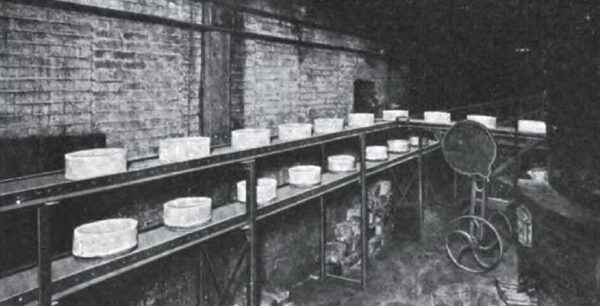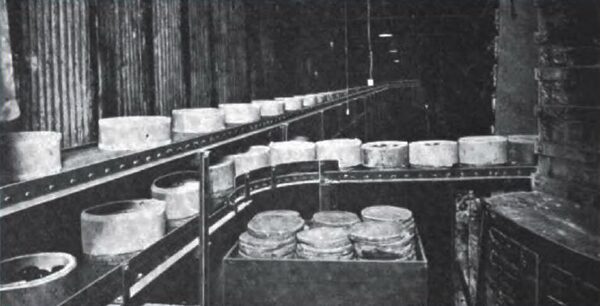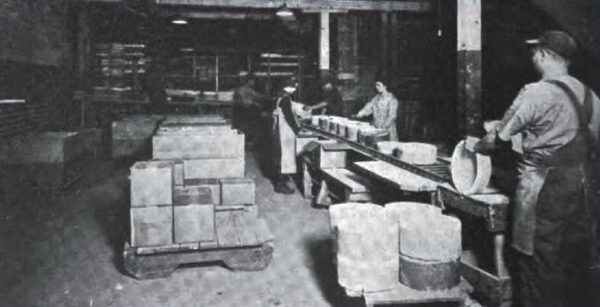[Trade Journal]
Publication: Industrial Engineer
Chicago, IL, United States
vol. 80, no. 8, p. 404-405, col. 1-3
Handling Porcelain at the Plant of the Square D Company by Conveyors
IN THE manufacture of porcelain and other fragile materials, the use of conveyors has often been discouraged because it has always been considered that too much jar and shock were necessarily connected with their use. However, when the Square D Company took over a porcelain factory at Peru, Ind., to make the porcelain parts connected with their safety switches and other electrical equipment, the entire method of handling materials was reorganized so that not only were they able to use conveyors, but also lift trucks. Perhaps the most radical departure from the common practice in porcelain work was in the method of loading and unloading the kilns. Under the old method of loading kilns the saggers, in which the unfired or green porcelain is placed for protection from heat and handling, were carried into the kiln by hand. It usually took a gang of from eight to ten men working both day and night, about twenty hours to fill a kiln. Now, however, two men in a kiln, one to pack the saggers in bungs and the other to assist him, will load a kiln in about nine hours. This makes it possible to fill a kiln in the daytime and fire it that night and so save several hours in the operation of a kiln.
|
|
| |||
| The Three Operations in This Porcelain Plant Were Conveyors Have Demonstrated Their Value -- (1) Loading the Kilns, (2) Unloading the Kilns, and (3) Inspecting and Packing. the Conveyor Belt Shown Along the Wall Serves Two Purposes. the Upper Belt Carries the Green Ware to the Portable Belt Section Which Takes It Into the Kilns, As Shown in the Illustration Above. by Means of A Special Device the Saggers of Green Ware Are Transferred to the Cross Belt Without Damage From Jarring. the Lower or Return Section of the Belt Carries the Fired Ware Back. How It is Taken Out of the Kiln on A Portable Section of Roller Gravity Conveyor is Shown in the Second Illustration and Explained in the Item. the Porcelain is Placed in Saggers, the Large White, Circular Containers Seen on the Belt Conveyor. These Protect the Green Ware When Handling and While Firing. the Inspecting and Packing Are Done on the Conveyor at the Right. |
The handling of unfired porcelain by conveyors presented a serious problem. In the first place, the kilns are all in a row and a conveyor which would distribute the saggers to these kilns would have to have some arrangement for discharging them onto a cross conveyor which would enter the kiln. This was finally solved by installing a belt conveyor, as shown in the upper left illustration, which is 180 ft. long and 14 in. wide, and travels the full length in front of the kilns. The top of the belt is placed about 6 ft. above the floor or 3 ft. above the kiln door and is located about 8 ft. from the doors of the kiln. The transfer from the longitudinal belt to the cross belt conveyors feeding the kiln is made by a portable section of belt conveyor which is also shown in this illustration. In making the turn, it was necessary to prevent undue jarring and not permit the saggers to touch each other. This cross conveyor, which carries the saggers into the kiln, is so arranged that when it is clamped across the main conveyor belt it depresses it enough to provide clearance for the cross belt to fit in place at the same level as the conveyor belt. In this way saggers traveling on the main belt strike the section of cross belt which is traveling at a right angle and, as they are both traveling slowly, rotate slightly until they are transferred entirely onto the cross belt. Both of these conveyors travel at the rate of 24 ft. per min. To insure that the saggers are placed sufficiently far apart so that they do not have any chance to come in contact, marks are placed on the belt 4 ft. apart and the operator must see that only one sagger is placed between two marks. The saggers are discharged from the cross conveyor onto a bench in the kiln which will allow for temporary storage of several saggers in case they come in so fast as to crowd the men in the kiln. When a kiln is loaded, two men can transfer the cross conveyor to the next kiln in about half an hour, as it is mounted on two large wheels, which may be seen in the first illustration.
This longitudinal belt serves a double purpose in that it is also used for unloading the kilns by carrying the saggers filled with fired porcelain on the lower or return section of the belt. As the fired porcelain is not as fragile as was the green porcelain, the sagger is transferred from the kiln to the lower or return belt on a roller gravity conveyor as shown in the second illustration. This is provided with a turn section of small-diameter rollers at the lower end and deposits the sagger on the belt without any undue jarring. However, as the bottom of the saggers are rough or some of them may be broken, it is necessary for the unloaders to place each sagger of fired ware on a wooden pallet or board before placing on the roller gravity conveyor. This also keeps the saggers apart so that they do not strike on the roller section.
The third illustration shows how a section of roller gravity conveyor is used for inspecting and packing of the fired ware. The saggers on the pallet are diverted from the return belt conveyor onto this roller gravity section and pass along in front of girls who inspect and pack the fired ware as it passes by. The empty saggers and pallets go on to the end of the conveyor where the saggers are placed on a lift truck platform at one side and the pallets are piled onto another on the other side, to be taken back to the next kiln to be unloaded and used again. In the unloading, one man will unload a kiln in nine hours while another man handles the empty saggers and pallets. In addition, four inspectors inspect and pack. It formerly required five men working about twenty hours continuously to unload a kiln, as the saggers had to be carried out one at a time, were dumped and inspected later. Under the former method of handling, there was considerably more breakage.
The savings here are not only the decrease in the number of men required, but also it has been found that a great deal less breakage and spoiling of both green and fired ware has resulted than by the former hand method which up to that time had been considered the only practical means of handling porcelain. Also it enabled the company to get out a much larger production than had been thought possible. The total saving is not easily computed, but if only two men were replaced by this equipment the saving in their wages would more than balance the interest and depreciation charges. The Dow Company, Louisville, Ky., installed the conveying system.



